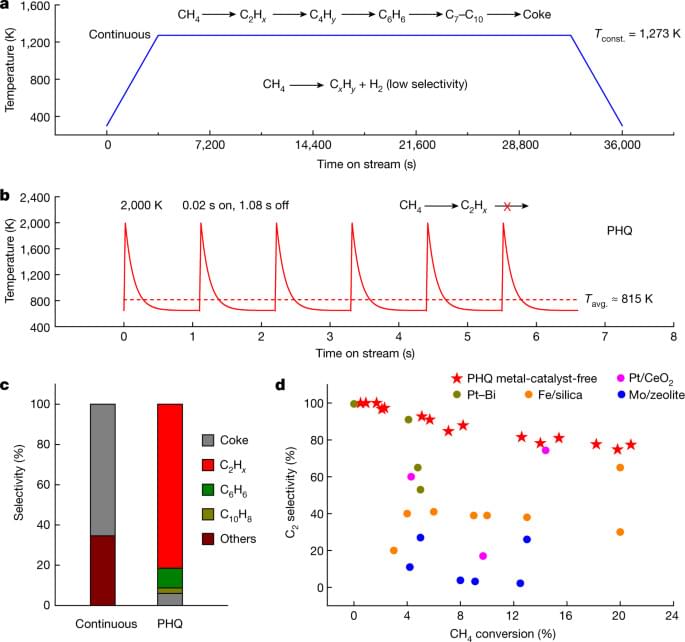A 36-year-old Florida man was sentenced by a Manhattan federal court to six months of home detention for knowingly allowing his cryptocurrency trading platform to act as a money laundering tool, the Department of Justice announced Friday.


Researchers at the University of Minnesota have made a major breakthrough that allows people to control a robotic arm using only their minds. The research has the potential to help millions of people who are paralyzed or have neurodegenerative diseases.
The study is published online today in Scientific Reports, a Nature research journal.
To read the full research paper, entitled “Noninvasive Electroencephalogram Based Control of a Robotic Arm for Reach and Grasp Tasks,” visit the Nature Scientific Reports website.
Groundbreaking study demonstrates potential to help millions of people with disabilities.

Astronomy was born when early scientists peered into the sky with their naked eyes and recorded what they could see above them. Then, the invention of the telescope brought forth new insights. And today, astronomers conduct their studies from big observatories and launch sophisticated telescopes into space for a much more in-depth look.
Now, a similar evolution is occurring in biology as scientists develop new techniques for taking a closer look at cells—the basic living units of organs. The origins of cell biology date back to 1,665 when Robert Hooke was the first to look at a cell under a simple compound microscope. But while the development of more powerful microscopes such as the scanning electron microscope has allowed scientists to take a peek at molecules smaller than a billionth of a meter, until recently they have never had the ability to look at the molecular profile of a single cell.
Yale researchers across disciplines are using single cell technologies to profile various kinds of cells that exist together in both healthy and diseased organs and create the most detailed blueprints of diseases to date, as well as to better understand how various cells develop over time and interact with one another. Through creating these “cell atlases” of organs throughout the body, they hope to shed light on the mechanisms of a wide variety of diseases and biological development.

The Festival will take place, from 7 to 9 July 2022, at the Archenhold Observatory in Berlin (Germany).
You are welcome to join the Festival in presence, sizing an excellent opportunity to visit the historic Archenhold Observatory and the beautiful city of Berlin. However, the Festival will be an hybrid conference, therefore virtual attendees are welcome as well.
Register here for free: https://spacerenaissance.space/register-to-the-space-renaiss…rlin-2022/
A detailed programme, and all the information — including logistics and hotels accommodations — are ** available on this page:**
**The agenda, in brief:** * The first day, 7 of July, focuses on ** Space Philosophy & Policy**, with a Panel on Civilian Space Development — How to accelerate it? How to support new space industry to achieve the goal of kicking off civilian space development within 2030? What should space agencies do, and what should the space activist organizations do? * The 8 of July, ** Astronauts and Civilians, Science & Tech Day**, will see two panels: on Space Habitats and Analog Training; Space Night, after dinner: Night Observation at the giant telescope * The 9 of July, the ** Space Art Day**, with two art panels, in German and English language.
The programme includes several keynote speakers, e.g. Seth Shostak (SETI), Giuseppe Reibaldi and John Mankins (Moon Village Association), Michelle Hanlon (NSS President), Bob Zubrin (Mars Society Founder), Jan Wörner (former ESA Director General), Bernard Foing (SRI President, chair of ITACCUS and EuroMoonMars). Many experts will tell us what’s going on on the edge of space settlement, science, art and exploration.
Several space artists will present their artworks, including: Priscilla Thomas, Mary Kuiper, Barbara King, and many members of the MoonMars art group.
The Festival will host the GALIX Congress 2022.

Benjy WangProbably could be limited by a simulation restart.
Jim RohrichNo limits.
Omuterema Akhahenda shared a link.
PHYSICS:
Our electronics can no longer shrink and are on the verge of overheating. But in a new discovery from the University of Copenhagen, researchers have uncovered a fundamental property of magnetism, which may become relevant for the development of a new generation of more powerful and less hot computers.

Subscribe — https://bit.ly/3myAZOn.
You’d be instantly where you want to be if you moved at the speed of light. Indeed, light-speed travel has been a fantasy of many scientists and aerospace engineers who look for ways to achieve it.
And now, it seems Elon Musk and NASA have broken that fantasy code to build a light-speed engine that defies the laws of physics.
About Elon Musk Live.
🎥 Videos about Elon Musk, SpaceX, Tesla, Neuralink, The Boring Company and more.
🔔 Subscribe for more Elon Musk, SpaceX, Tesla, Neuralink, The Boring Company and more.
📝 Written, voiced and produced by Elon Musk Live.
Watch More Elon Musk Live Videos Here:
👑 Elon Musk: https://www.youtube.com/playlist?list…
🚀 SpaceX: https://www.youtube.com/playlist?list…
🚗 Tesla: https://www.youtube.com/playlist?list…
⚠️ Copyright Disclaimers.
• Section 107 of the U.S. Copyright Act states: “Notwithstanding the provisions of sections 106 and 106A, the fair use of a copyrighted work, including such use by reproduction in copies or phonorecords or by any other means specified by that section, for purposes such as criticism, comment, news reporting, teaching (including multiple copies for classroom use), scholarship, or research, is not an infringement of copyright.”
• We use images and content in accordance with the YouTube Fair Use copyright guidelines.
#ElonMusk #SpaceX #NASA

Large language models (LLMs) have been shown to be capable of impressive.
few-shot generalisation to new tasks. However, they still tend to perform.
poorly on multi-step logical reasoning problems. Here we carry out a.
comprehensive evaluation of LLMs on 50 tasks that probe different aspects of.
Logical reasoning. We show that language models tend to perform fairly well at.
Single step inference or entailment tasks, but struggle to chain together.
multiple reasoning steps to solve more complex problems. In light of this, we.
Propose a Selection-Inference (SI) framework that exploits pre-trained LLMs as.
General processing modules, and alternates between selection and inference to.

A strategy for investigating consciousness that has proven very productive has focused on comparing brain processes that are accompanied by consciousness with processes that are not. But comparatively little attention has been given to a related strategy that promises to be even more fertile. This strategy exploits the fact that as individuals develop, new classes of brain processes can transition from operating ‘in the dark’ to becoming conscious. It has been suggested that these transitions occur when a new class of brain processes becomes object to a new, emergent, higher-level subject. Similar transitions are likely to have occurred during evolution. An evolutionary/developmental research strategy sets out to identify the nature of the transitions in brain processes that shift them from operating in the dark to ‘lighting up’. The paper begins the application of this strategy by extrapolating the sequence of transitions back towards its origin. The goal is to reconstruct a minimally-complex, subject-object subsystem that would be capable of giving rise to consciousness and providing adaptive benefits. By focusing on reconstructing a subsystem that is simple and understandable, this approach avoids the homunculus fallacy. The reconstruction suggests that the emergence of such a minimally-complex subsystem was driven by its capacity to coordinate body-environment interactions in real time e.g. hand-eye coordination. Conscious processing emerged initially because of its central role in organising real-time sensorimotor coordination. The paper goes on to identify and examine a number of subsequent major transitions in consciousness, including the emergence of capacities for conscious mental modelling. Each transition is driven by its potential to solve adaptive challenges that cannot be overcome at lower levels. The paper argues that mental modelling arose out of a pre-existing capacity to use simulations of motor actions to anticipate the consequences of the actions. As the capacity developed, elements of the simulations could be changed, and the consequences of these changes could be ‘thought through’ consciously. This enabled alternative motor responses to be evaluated. The paper goes on to predict significant new major transitions in consciousness.